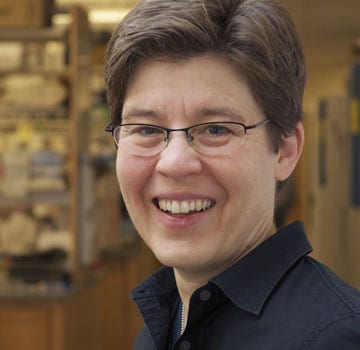 Jennifer A. Lewis has published extensively in Advanced Materials since 2002 and joins the Editorial Advisory Board of the journal this summer. She brings a wealth of experience to the advisory board, which she adds to her current roles on the advisory boards of Advanced Functional Materials and Soft Matter. Her most-recent published work in Advanced Materials involves studies of high-throughput printing via microvascular multinozzle arrays and 3D printing of lithium ion microbatteries.
Jennifer A. Lewis has published extensively in Advanced Materials since 2002 and joins the Editorial Advisory Board of the journal this summer. She brings a wealth of experience to the advisory board, which she adds to her current roles on the advisory boards of Advanced Functional Materials and Soft Matter. Her most-recent published work in Advanced Materials involves studies of high-throughput printing via microvascular multinozzle arrays and 3D printing of lithium ion microbatteries.
Jennifer is Hansjorg Wyss Professor of Biologically Inspired Engineering at Harvard School of Engineering and Applied Sciences in Cambridge, MA, USA; she is also a Core Faculty Member at the Wyss Institute for Biologically Inspired Engineering at Harvard. Her research focuses on materials and devices, biological and artificial systems, and energy and environmental systems. Her work integrates materials synthesis, complex fluids, microfluidics, and 3D printing to design and create functional materials with controlled composition and architecture across multiple length scales.
 She earned her Bachelor of Science degree in ceramic engineering in 1986 at the University of Illinois at Urbana-Champaign and her doctorate in ceramics science at MIT, Cambridge, MA USA in 1991. She has received numerous distinctions, including the NSF Presidential Faculty Fellow Award, the Brunauer Award from the American Ceramic Society, the Langmuir Lecture Award from the American Chemical Society and the Materials Research Society Medal. She is a Fellow of the American Ceramic Society, the American Physical Society, the Materials Research Society, and the American Academy of Arts and Sciences.
She earned her Bachelor of Science degree in ceramic engineering in 1986 at the University of Illinois at Urbana-Champaign and her doctorate in ceramics science at MIT, Cambridge, MA USA in 1991. She has received numerous distinctions, including the NSF Presidential Faculty Fellow Award, the Brunauer Award from the American Ceramic Society, the Langmuir Lecture Award from the American Chemical Society and the Materials Research Society Medal. She is a Fellow of the American Ceramic Society, the American Physical Society, the Materials Research Society, and the American Academy of Arts and Sciences.
Jennifer is passionate about science and education and has been involved in education and outreach for nearly twenty years. She recently co-founded a company, Electroninks Incorporated, to commercialize conductive inks for printed electronics. In addition to innovation and entrepreneurship, she has been involved in shaping new directions in science and technology through her service to several federal agencies.

















